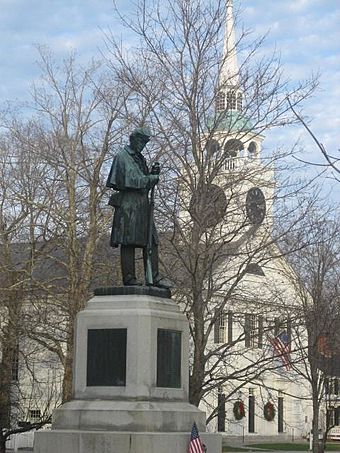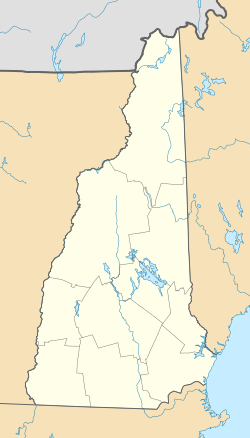Amherst Village Historic District facts for kids
Quick facts for kids |
|
|
Amherst Village Historic District
|
|
 |
|
| Location | NH 122, Amherst, New Hampshire |
|---|---|
| Area | 160 acres (65 ha) |
| Architect | Multiple |
| Architectural style | Greek Revival, Federal, Cape |
| NRHP reference No. | 82001679 |
| Added to NRHP | August 18, 1982 |
The Amherst Village Historic District is a special area in Amherst, New Hampshire. It's like a time capsule, showing what a New England village looked like a long time ago, especially in the late 1700s and early 1800s. This historic district is built around the town's common, which is a big open grassy area. This common was first set up around 1755.
The district covers a large area. It stretches from Foundry Street in the north to Amherst Street in the south. On the west side, it goes to Davis Lane, and on the east, it includes Mack Hill Road, Old Manchester Road, and Court House Road.
Contents
Discovering Amherst Village
This historic area is famous for its many old buildings. You can find the Congregational Church here, which was built between 1771 and 1774. Most of the buildings are homes, and they show off different old styles. These include Georgian, Federal, and Greek Revival designs.
Important Buildings to See
Besides the homes, there are other cool old buildings.
- The Farmer's Bank is a brick building from 1806. It's built in the Federal style, which was popular back then.
- The Amherst Brick School is another brick building. It's in the Greek Revival style and is now used as a community center.
A Glimpse into the Past
Amherst was first explored in 1735. People started settling here after 1749. Many of the first settlers were veterans from King Philip's War who came from Massachusetts.
Early Days of Amherst
The town's first meeting house, a place for both church and town meetings, was built in 1749. It was first on a hill, but then moved to the common after Amherst became an official town in 1760. Some houses built around 1750 are still standing today. One of these was even used as a tavern, a place where people could eat, drink, and stay.
Why Amherst Was Important
Amherst became the first "shire town" for Hillsborough County in 1769. A shire town was like the main town for the county, where important government business happened. Amherst was a good spot because it was about halfway between Boston, Massachusetts and Lake Champlain. This location helped the town's economy grow.
The current town hall was built in 1825. It was originally the county's third courthouse.
Changes Over Time
Later, Amherst became less important. People started moving to other places, like the American Midwest, where there was more fertile land. Also, the town didn't get as many factories or industries as other places. Because of this, in 1862, the county government moved its offices to bigger industrial towns like Nashua and Manchester.
Preserving History
The Amherst Village Historic District was officially added to the National Register of Historic Places in 1982. This means it's recognized as an important historical site in the United States.
One specific building, the Hildreth-Jones Tavern at 18 Jones Road, was also added to the New Hampshire State Register of Historic Places on January 26, 2004. This shows how important it is to protect these old buildings and the history they represent.



